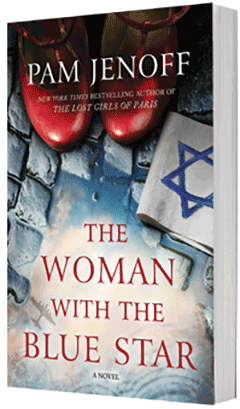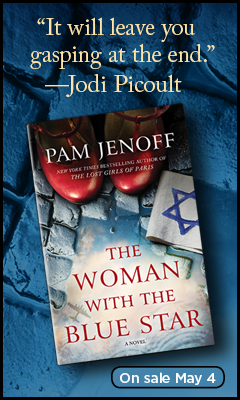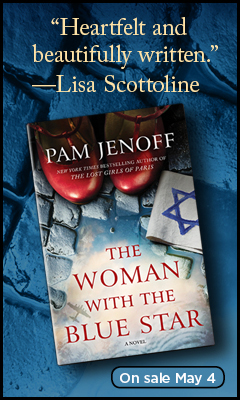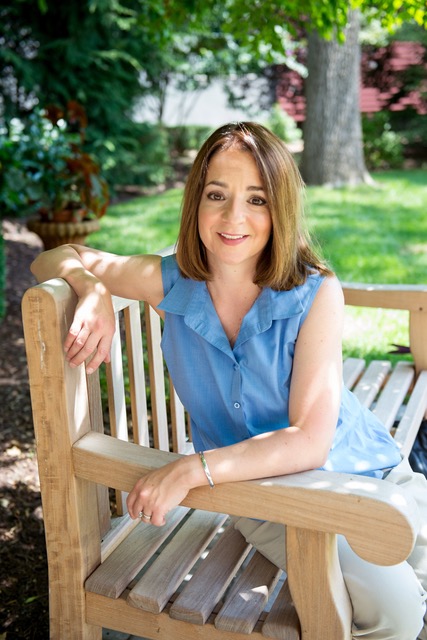The Woman with the Blue Star
by Pam Jenoff
If one is ever worried that the genre of World War II fiction might have become overstuffed, turn to Pam Jenoff for a quick recalibration. Time and again, the author has demonstrated such a keen eye for research that her books all but burst with originality, even in a field where seemingly every angle has been covered at least twice. Her latest, The Woman with the Blue Star, is no different.
In The Woman with the Blue Star, two young Polish women from opposite backgrounds come together through the hazy light of a sewer grate. Sadie Gault, forced out of her decrepit apartment in the Jewish ghetto in Kraków by the encroaching German forces, lives underground with her pregnant mother and another family, surviving on potatoes and hungry flickers of light. Meanwhile, Catholic Ella Stepanek lounges in a fine house across the city, where her stepmother regularly hosts Nazi guests. But Ella hates the Nazis, hates what they've done to her country and its people, and her anger ignites a bravery she didn't know she possessed.
When Ella sees a girl's face in the shadows of a sewer grate, she's tempted to ignore what she witnessed. Instead, her conscience lures her back, and she returns again and again, becoming Sadie's lifeline as well as her closest friend. But keeping Sadie alive puts her own life at risk, as well as those of Sadie and her own connections--including the resistance fighter she's fallen in love with. Eventually, bringing small bundles of food to Sadie becomes untenable, and the friends hatch a plan to ferry her and the other sewer-dwellers to safety. But if rumors reach the Germans and they decide to search the tunnels, all will be lost. To spar against the near-impossible odds, they'll need to trust others, and that means bringing more allies into imminent danger.
Jenoff, who is no stranger to World War II fiction--her other works include The Orphan's Tale, The Kommandant's Girl and The Lost Girls of Paris--often bases her novels on real events, and The Woman with the Blue Star is no different. As a member of the Foreign Service, Jenoff was assigned to the U.S. Consulate in Kraków in the '90s and fell deeply in love with Poland, which eventually led her to the story of Leopold Socha, a sewer worker who aided Jews hiding underground during the war. The novel she has spun from this piece of history is a startling adventure that never feels fantastical, and is so surrounded by real events that it's impossible to escape the horror.
It is similarly impossible to separate The Woman with the Blue Star from the context in which it was written and released. The story is about courage, survival and friendship, but also largely about isolation, and the way such separation from the thrum of life tears at our sanity. Jenoff wrote much of the book during the pandemic-induced quarantine, and many readers will only just be getting back to some semblance of normalcy when they read it. The pain of the past year will still feel raw. Although it would be wrong to equate what happened to people like Sadie during World War II with what has happened in 2020 and 2021, many readers will nevertheless recognize Sophie's bored despair. With so much collective loss and grief, plus little way to share it with the outside world, life loses its color. Survival starts to have little meaning. It takes another--in Sadie's case, an outsider like Ella--to remind us for what, and for whom, we're fighting. The Woman with the Blue Star accomplishes this with a gasping, heart-wrenching finale, one readers will not be able to stop thinking about. The result is not the save-the-day scenario of comic books; that would be too trite, too unrealistic. Instead, there is enormous loss. But that rings true, and readers will appreciate the equal timbre of solemnity and hope that echoes after the novel ends.
This is a story of surprising complexity within such an insular setting. Writing an adventure set within the confines of a concrete tunnel is no easy feat, and even trickier is the ability to make isolation feel motivating rather than debilitating. Sadie and Ella are inundated with grief, yet it never drowns the reader; instead, it compels them to dive deeper and deeper into the story. The Woman with the Blue Star is a mesmerizing tale of courage and heartbreak in an almost inconceivable time--a time that should never be forgotten. --Lauren Puckett








